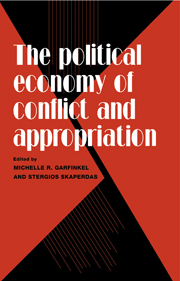Book contents
- Frontmatter
- Contents
- List of contributors
- Acknowledgments
- 1 Introduction: Conflict and appropriation as economic activities
- 2 Anarchy and its breakdown
- 3 Towards a model of territorial expansion and the limits of empire
- 4 Predation and production
- 5 Competitive trade with conflict
- 6 Increasing returns to politics in developing countries with endogenous protection in a fixed-factor model
- 7 Demosclerosis, or special interests “R” us: An information rationale for political gridlock
- 8 Deforestation, investment, and political stability
- 9 Violence and the assignment of property rights on two Brazilian frontiers
- Index
3 - Towards a model of territorial expansion and the limits of empire
Published online by Cambridge University Press: 30 December 2009
- Frontmatter
- Contents
- List of contributors
- Acknowledgments
- 1 Introduction: Conflict and appropriation as economic activities
- 2 Anarchy and its breakdown
- 3 Towards a model of territorial expansion and the limits of empire
- 4 Predation and production
- 5 Competitive trade with conflict
- 6 Increasing returns to politics in developing countries with endogenous protection in a fixed-factor model
- 7 Demosclerosis, or special interests “R” us: An information rationale for political gridlock
- 8 Deforestation, investment, and political stability
- 9 Violence and the assignment of property rights on two Brazilian frontiers
- Index
Summary
The question of the size of political units never seems to attract among historians and sociologists the attention which it deserves. What determines why states and empires have expanded to the limits which they have historically achieved? What are the conditions under which it has been possible to maintain those frontiers? Why have the larger states normally broken up into fragments after a certain period of time? As a general problem – distinct from the specific question of why particular units have disintegrated – this is still largely unexplored territory.
Adding economists to historians and sociologists in the first sentence of this quotation from the eminent Sinologist, Mark Elvin (1973, p. 17) only enhances its salience. Insofar as they are considered at all in economics, the boundaries of a given economic system or “country” are generally regarded as given, along with the population living within those boundaries. Yet it is obvious that, however sanctified these boundaries may have become in international law, they were all at one time or another contested between rival claimants and determined ultimately by the balance of economic and military power between the contending parties. The process by which these boundaries are determined and defined clearly depends on the interplay of economic and military forces, which have, however, generally been regarded as independent factors.
- Type
- Chapter
- Information
- The Political Economy of Conflict and Appropriation , pp. 41 - 56Publisher: Cambridge University PressPrint publication year: 1996
- 14
- Cited by



